If you have had a posterior or lateral hip replacement, to find a good height for your chair seat you need to measure from the floor to the back of your knee, to the point that it bends, and make sure that your chair seat is at the least the same height from the floor, if not an inch or so higher. You must not have your hip lower than your knees when you are seated.
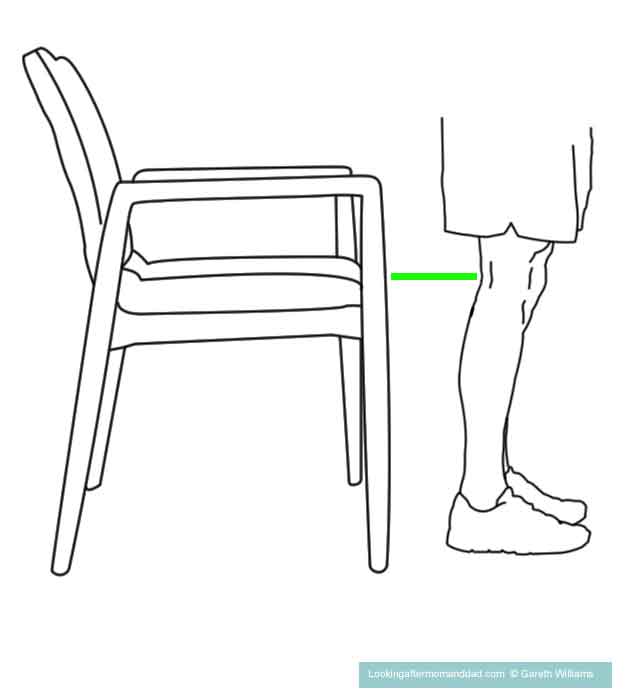
CONTENTS - Overview & Quick Links
What’s the best chair after a hip replacement ?
Positions to avoid after a posterior, or a lateral, hip replacement
Positions to avoid after an anterior hip replacement
How to get out of a chair after a hip replacement ?
How to sit down in a chair after a hip replacement ?
When can I sit in a normal chair after a hip replacement ?
Can I sit with my legs up after a hip replacement ?
Using a recliner after a hip replacement: Can you do it ?
What’s the best chair after a hip replacement ?
If you had an anterior hip replacement, you really don’t have to worry about this, unless of course your surgeon has told you to take some precautions involving chairs.
It is wise to avoid any really low chairs, and if the chair has armrests that can make it easier for you to stand up in the early stages of your recovery.
Most of the time, the precautions to avoid bending your hip more than 90 degrees do not apply to anterior hip replacements.
For patients who had a posterior or lateral hip replacement, you want to get a chair with –
- armrests – you need these to help you when standing up
- a straight back
- a seat which is higher from the floor than the back of your knees, so you are that your hip does not bend more than 90 degrees – if your hip is higher than your knee that is fine
- you should be able to place your feet flat on the floor when you are seated – no dangling, or even half up in the air – this is for safety when standing
- a firm but comfortable seat
You should stay away from low seats, puffy seats, sofas and seats without armrests.
You can always add a wedge cushion or a square cushion of dense foam, 2 to 4 inches thick, to make things a little more comfy if you have a chair which you find a bit hard.
But there is absolutely no need to go spending a fortune on a chair, especially as you will only be using it for 6 to 10 weeks, in most cases.
My mom used a very basic upright wooden chair with armrests, and a slightly padded back and seat. The seat level was about 1 inch higher than her knees, so she was fine with the 90 degree rule for her hip.
If you have had a posterior or lateral hip replacement you will also want to know how to measure a toilet for a raised toilet seat, you can read my article explaining how to check and measure the toilet to see if you have an elongated or a standard toilet bowl – that’s important too – and how to measure yourself to find out how much of a lift your seat needs.
That article is here – “How To Measure For A Raised Toilet Seat”.
Now let’s take a look at what the correct seating positions are, and in what avoid positions you should avoid after a hip replacement.
Positions to avoid after a posterior, or a lateral hip replacement
When lying down, standing, sitting, sitting down and standing up, after a “posterior” or “lateral” hip replacement, there are a number of precautions which need to be taken, in order to give the hip the time to heal.
All of these precautions are related to the angle of the hip to the body, and are there to stop a person from over flexing the hip, and causing it to dislocate, or twisting it, and causing complications.
The 90 Degree Rule
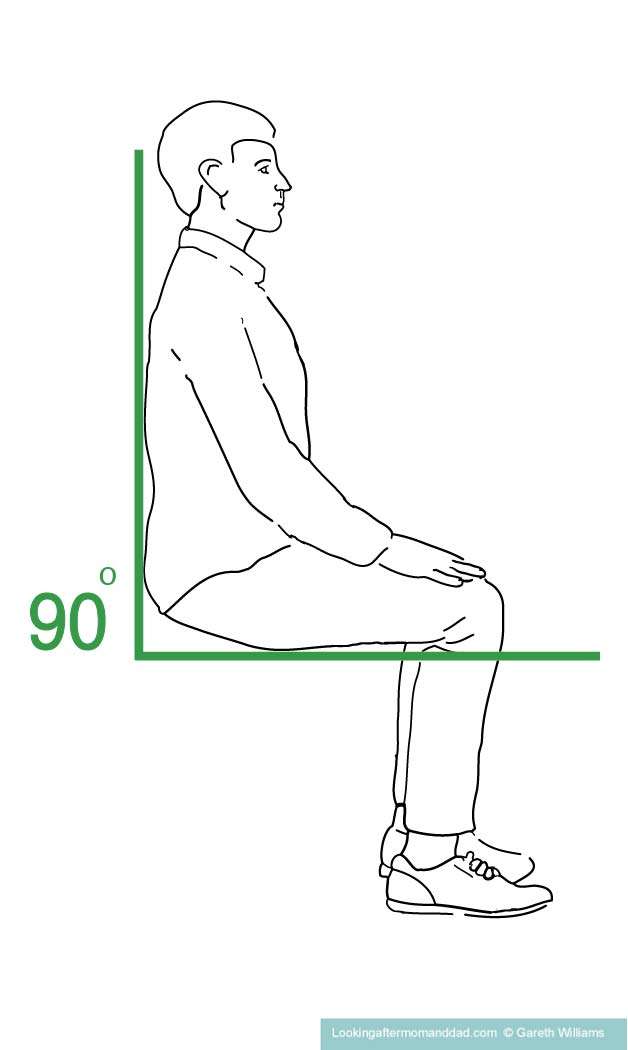
Illustration 1/
Illustration 1/, above, demonstrates the 90 degree rule for the sitting position.
This is the closest the knee, of the leg with the hip replacement, should come to your chest when you are sitting.
In the seated position, your hip should not be lower than your knees – it can be higher than the knees, but never lower.
In the seated position above, you should –
- neither lean your torso forwards to the knees
- nor lift the knees upwards
During the first 6 to 12 weeks, the recovery period after you had your hip replacement, your hip should not be at a greater angle than 90 degrees – your surgeon will let you know when you can stop taking the precautions, but everyone is different, and so is their recovery time.
– if you are finding this 90 degree this angle business is a little confusing, imagine that a standing person’s hip is at 0 degrees to the torso, so when the leg lifts upwards, the angle builds up, and where the leg and hip are at a right angle to the body (90 degrees), you are at the maximum amount that you are supposed to bend your hip during the precaution period post surgery.
The forward movement of the hip upwards is called flexion, and movement of the hip backwards is referred to as extension.
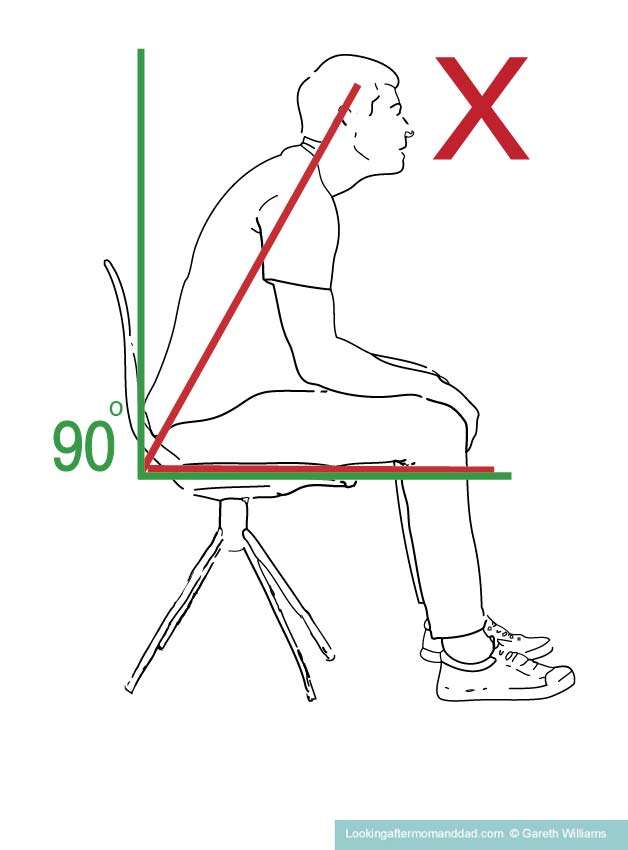
Illustration 2/
Illustration 2/, above, shows you are not to lean forwards, even a little bit, when seated, as this will exert pressure on the new hip replacement – some of the biggest muscles in the buttocks have been cut, and the hip could move backwards, if you put pressure on it like this, before it has had time to heal.
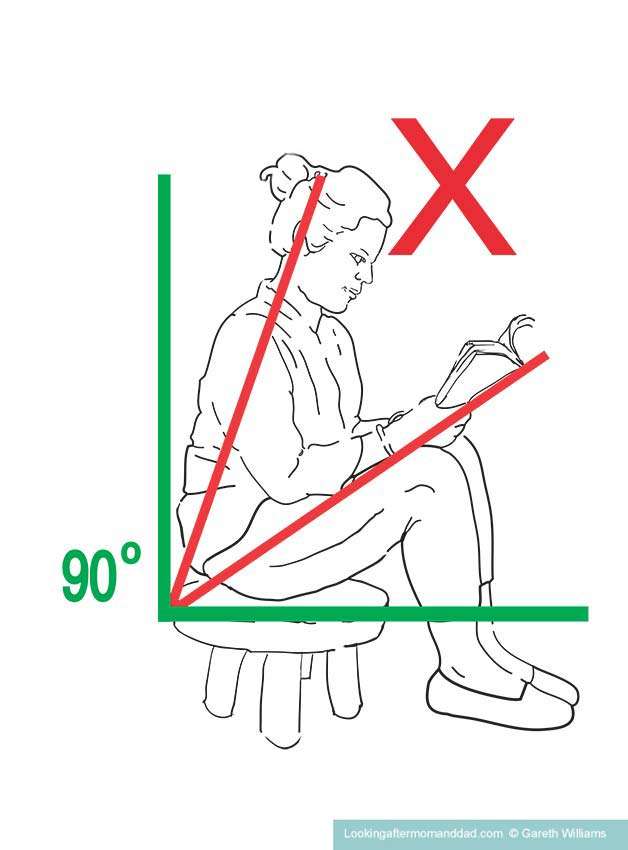
Illustration 3/
Illustration 3, above, demonstrates several things you cannot do after a posterior or lateral hip replacement –
- the bottom is lower than the knees
- the character is leaning forwards
This is going to create multiple problems for the sitter.
The bottom, being positioned at a lower level than the knees, is already exerting too much pressure on the hip, but it will also then cause a far greater concern for standing up.
As the sitter tries to stand up, they will not be able to do so, without leaning forwards to gain momentum to lift themselves upwards.
And this leaning forwards will even further reduce the distance between the knees/thighs and the torso, exerting a lot more pressure still, on the hip replacement, and greatly increasing the chance of a dislocation of the hip.
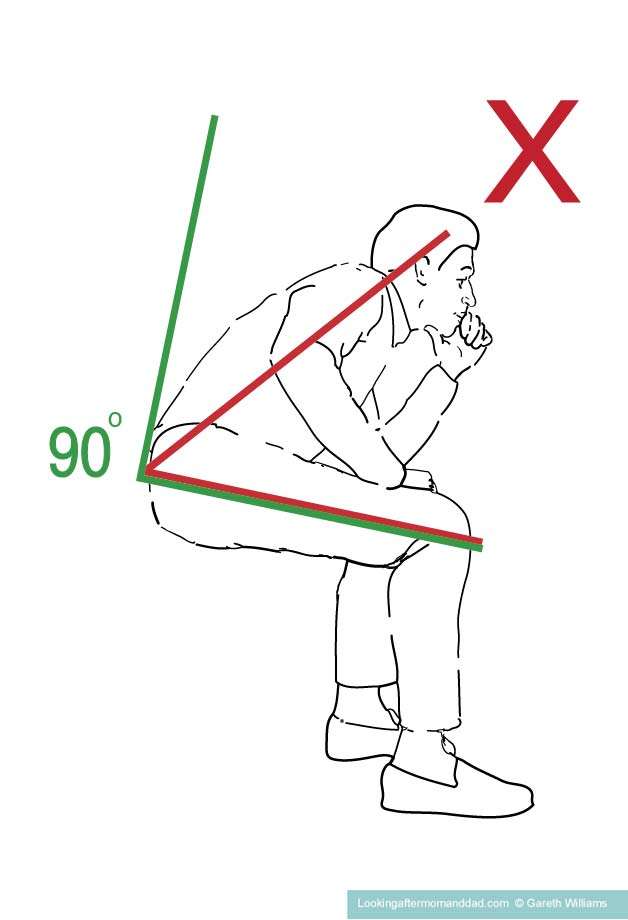
Illustration 4
The torso, in this situation, should be well behind the green line, which is behind it
If the figure were sitting upright, and there would be at about a 110-degree angle between the torso and the thighs, which would be ideal
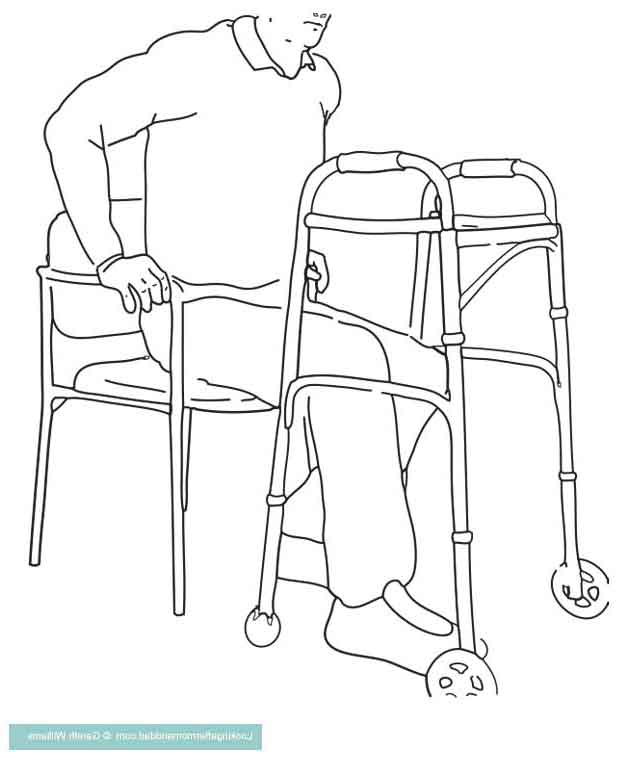
Illustration 5
Armrests
Armrests are recommended for the chairs you sit in, as they will help you to sit down and to stand up correctly while maintaining good posture and not to lean forwards.
Illustration 5/, above, demonstrates how you should use the armrests of a chair to push up vertically to stand, stopping you from leaning forwards for momentum – your arms will provide the thrust to rise up.
Without armrests, you have no choice but to lean forwards to build the momentum (even if you push up from the seat with one hand), exerting extra pressure on the new hip replacement.
If you want to know how to sit down, or stand up, after a posterior or lateral hip replacement, using a walker, on a toilet with a raised toilet seat, but without armrests, I have an illustrated article “How To Sit On A Toilet After Hip Surgery: A Detailed Illustrated Guide”.
Again, I would like to point out that the article above is not for patients who have had an anterior hip replacement.
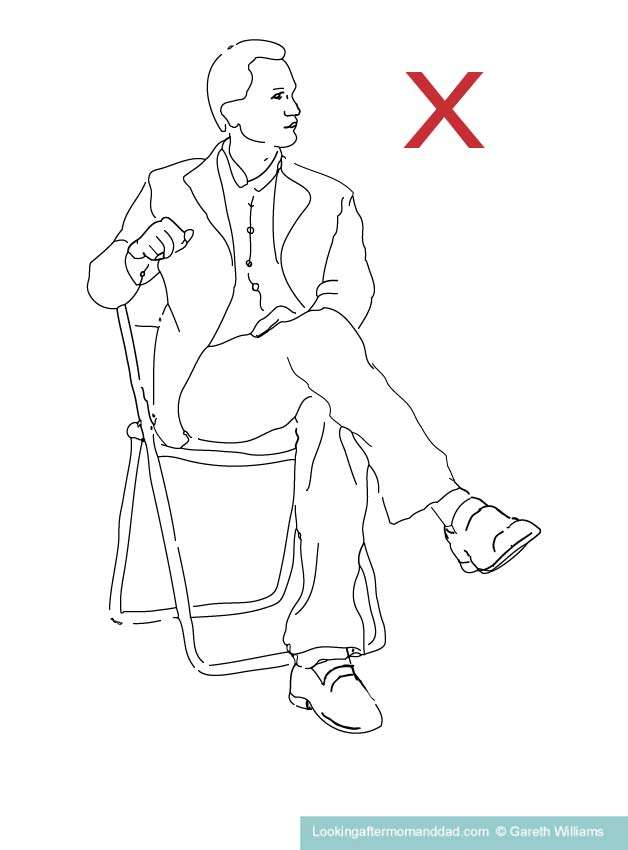
Illlustration 6/
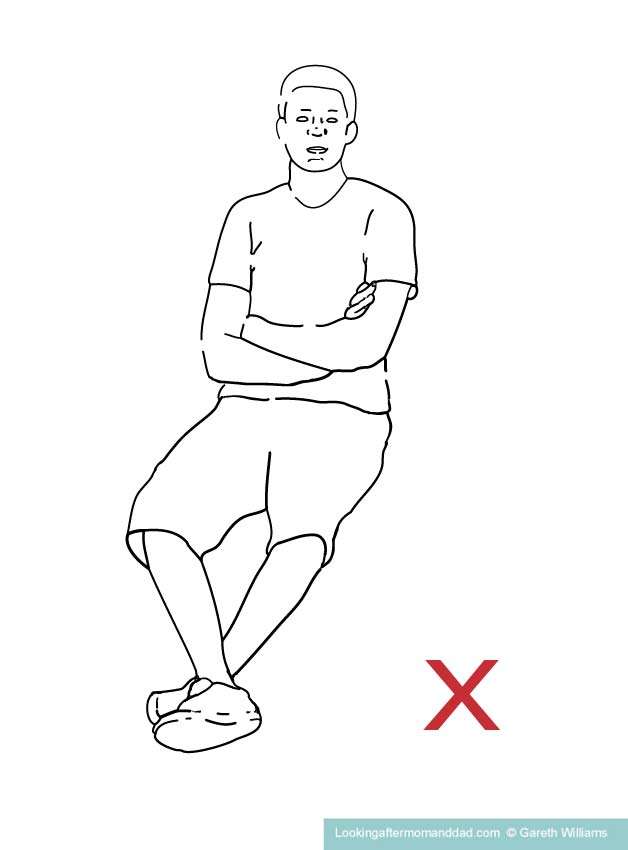
Illustration 7/
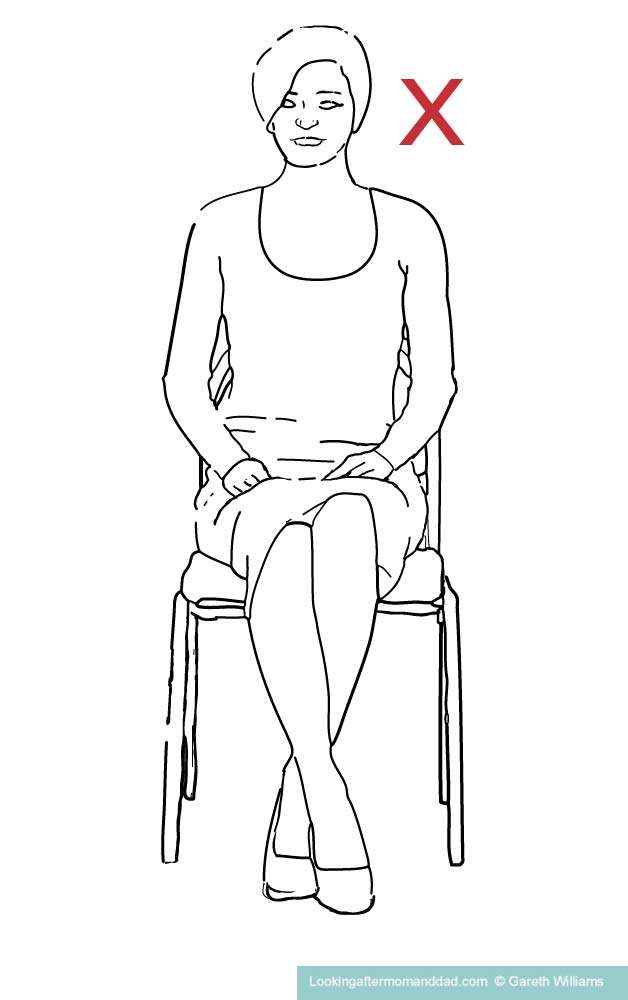
Illustration 8/
Don’t cross your legs after surgery
Illustrations 6-8 show a few more positions to avoid with your legs crossed.
While your muscles around the hip joint are still healing from the surgery, you will be advised to keep your legs straight – not to cross them, and not to turn them inwards in any way.
This will typically be for the first 10 to 12 weeks.
This applies to sitting, standing and sleeping positions as you will see below.
Sleeping positions
For sleeping there are a number of precautions both for the 90 degree rule and for twisting the hip –
- do not sleep on your stomach – it forces your feet to point in or out, which twists your leg and hip
- the best position for sleeping is on your back
- do not put pillows under your knees if you are sleeping on your back
- have a pillow between your legs to stop you from twisting them, if you are sleeping on your back, only let your toes point straight up
- if you are going to sleep on your side, you must not sleep on the hip replacement
- if you are sleeping on your side, you also have to put a couple of pillows between your legs, this keeps your hip at a neutral angle
- do not bend your knees beyond the 90 degree point for hip, when you are sleeping on your side
- don’t cross your legs when you are lying down, or sleeping
- when you are lying in bed, do not reach forwards to pull up covers – always use a reacher
Standing positions
There are only a few precautions for when you are standing and walking –
- do not bend down or lean forwards to pick things up – use a reacher
- stand with your toes pointing ahead of you, or slightly to the outside, but don’t let them point inwards – it twists the hip
- do not pivot on your foot – if you want to turn you do so with small steps
- do not twist your upper body when you are standing
Positions to avoid after an anterior hip replacement
After an anterior hip replacement, you may have a few precautions for up to 6 – 12 weeks, and your surgeon will let you know when you are okay to stop taking them.
During the surgery, the “anterior capsule” has to be cut through, so the surgeon can place the implants in. This capsule contains soft tissue ligaments, and it may take around 4 months for the capsule to “re-form”, during which time you have to take care, but nothing like with the posterior and lateral hip replacements.
So you may be asked to avoid –
- flexing the hip beyond 120 degree for the first 6 weeks
- doing sit-ups
- twisting or pointing the leg and foot to the outside – even pointing your toes to the outside is too much
- when you turn, do not pivot on your leg – take a series of smaller steps
- hip hyperextension – this means extending your leg behind you, do not step backwards on your surgical leg, don’t extend your leg behind you, do not bend backwards
- do not push your hips forwards, or do a bridge
- when sleeping on your back, do it with a pillow between your legs to stop the hip from twisting
- putting a pillow under your knees if you are sleeping on your back, as this will put pressure on your hips, and can lead to complications
- do not twist your knee outward in any sleeping position
- don’t cross your legs when lying down – put pillow when rolling onto your side
- if you don’t like to sleep on your back, sleep on the side without the surgery, and put pillows between your legs to align the hips
- never lie, or sleep, on your stomach
- do not sleep in a recliner – it will cause the hip to become stiff and harder to straighten out
Activities which push the knee towards the head are not typically a problem, as none of the muscles and ligaments at the back of the hip have been cut through.
How to get out of a chair after a hip replacement ?
This only applies to posterior and lateral hip replacements.
To get out of a chair after a hip replacement, you will be using a walker to help you with your stability and balance.
A quick guide to getting out of a chair after a hip replacement –
1.
- extend your operated hip leg out in front of you (no weight-bearing at this point on the operated hip)
- place your hands on the armrests of your chair
- scoot yourself forwards to the edge of your chair without leaning forwards, and using your arms on the armrests to lift you a little as you do so
2.
- as you are about to stand, make sure your good leg is tucked back under you a little – doing this will give you more lift, and stop you from leaning forwards to gain momentum
3.
- push up vertically with your arms from the armrests, without leaning forwards and stand up
- do not push up with your operated leg, it should not be load bearing as you stand
4.
- take hold of the walker with your hand on the side of your leg
- momentarily, keeping your other hand on the chair armrest on the other side
5.
- take hold of the walker with the other hand
6.
- bring the leg with the hip replacement back to a normal standing position
- do not put too much weight on your operated hip if you are not supposed to be weight-bearing on it, just use the frame to do that
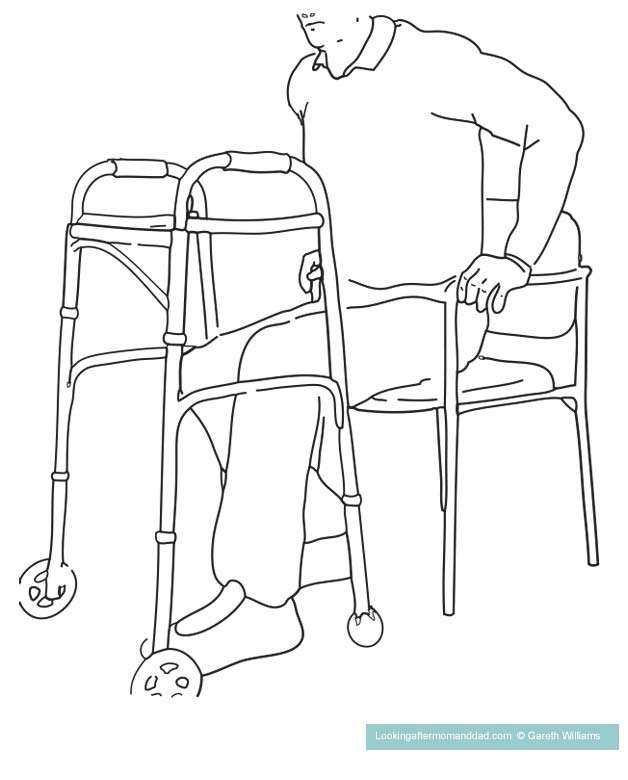
1
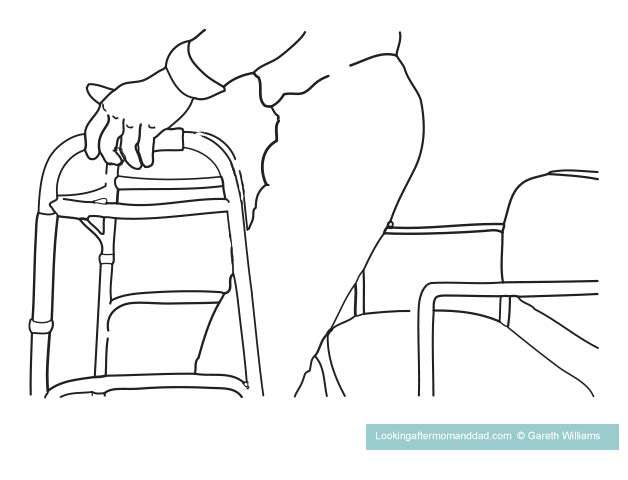
4
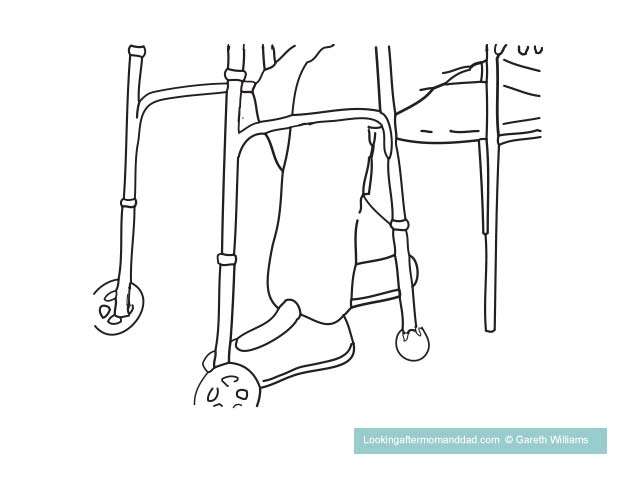
2
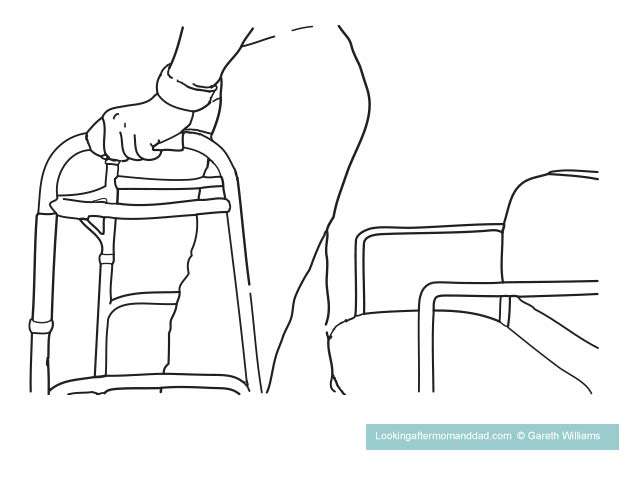
5
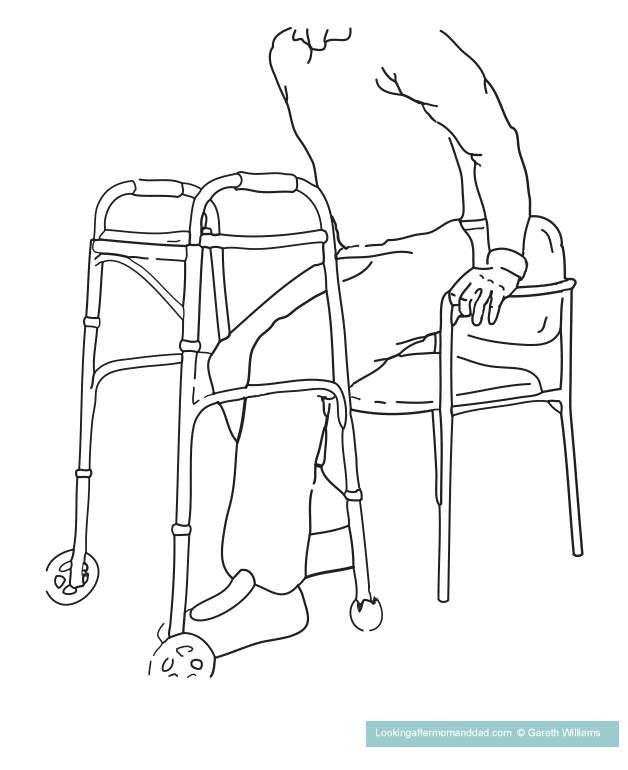
3
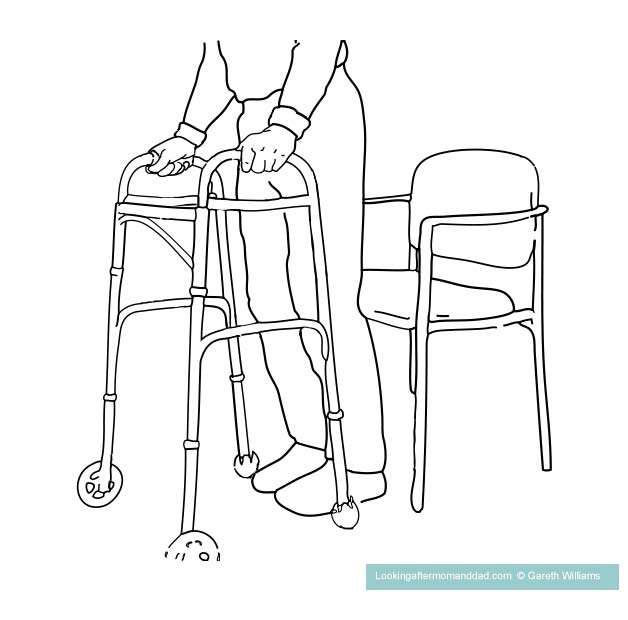
6
How to get out of a chair after a hip replacement ?
To get out of a chair after a hip replacement, you will be using a walker to help you with your stability and balance.
A quick guide to getting out of a chair after a hip replacement –

1
- extend your operated hip leg out in front of you (no weight-bearing at this point on the operated hip)
- place your hands on the armrests of your chair
- scoot yourself forwards to the edge of your chair without leaning forwards, and using your arms on the armrests to lift you a little as you do so

2
- as you are about to stand, make sure your good leg is tucked back under you a little – doing this will give you more lift, and stop you from leaning forwards to gain momentum

3
- push up vertically with your arms from the armrests, without leaning forwards and stand up
- do not push up with your operated leg, it should not be load bearing as you stand

4
- take hold of the walker with your hand on the side of your leg
- momentarily, keeping your other hand on the chair armrest on the other side

5
- take hold of the walker with your other hand

6
- bring the leg with the hip replacement back to a normal standing position
- do not put too much weight on your operated hip if you are not supposed to be weight-bearing on it, just use the frame to do that
How to sit down in a chair after a hip replacement ?
Again, this is only for posterior and lateral hip replacements.
To sit down in a chair after a hip replacement, you will be using a walker to help you with your stability and balance.
A quick guide to sitting down in a chair after a hip replacement –
1.
- using a walker, back up to the chair
2.
- stop when you feel the back of your legs touching against the seat of the chair
3.
- extend your leg out in front of you without putting weight on it
4.
- reach back with your hand on your hip replacement side for the armrest of the chair same side
- once you have hold of the armrest, you can reach back with the other hand taking hold of the other armrest
- now putting your weight into your arms, and your good leg, you can sit back on the front edge of the seat
- as you sit down do not bend or lean forwards, but take your weight down through your arms keeping your back nice and straight
5.
- sit back on the front edge of the chair seat
6.
- using your arms, lift your weight off your bottom, and scoot back further into the seat
- as well as your arms, you can use your good leg to help you scoot back, but don’t twist your hips
- don’t lean forwards to do this
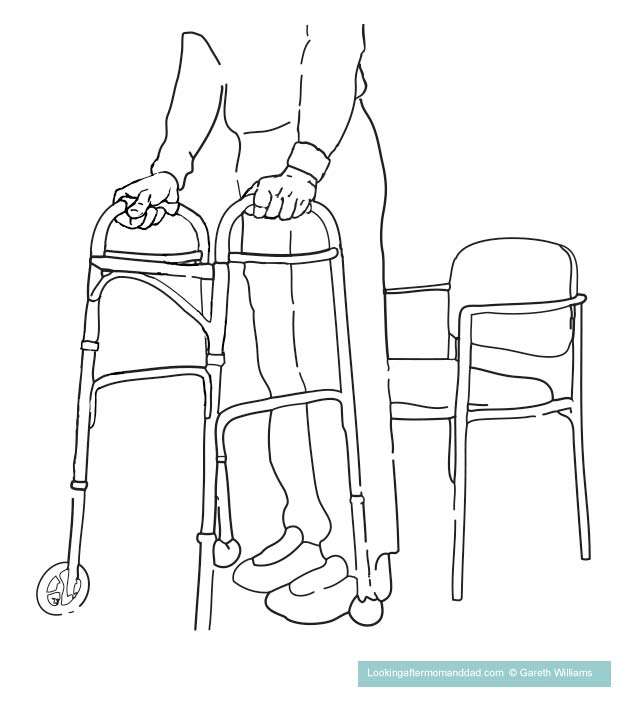
1
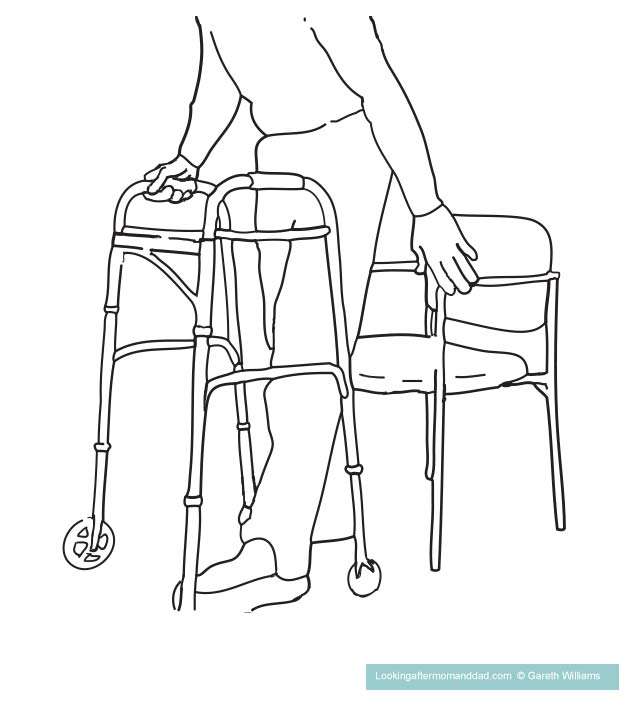
4
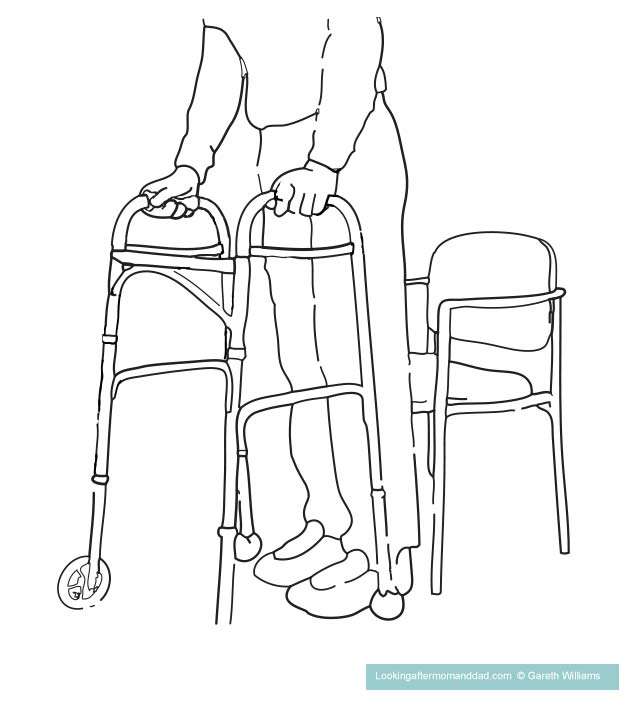
2
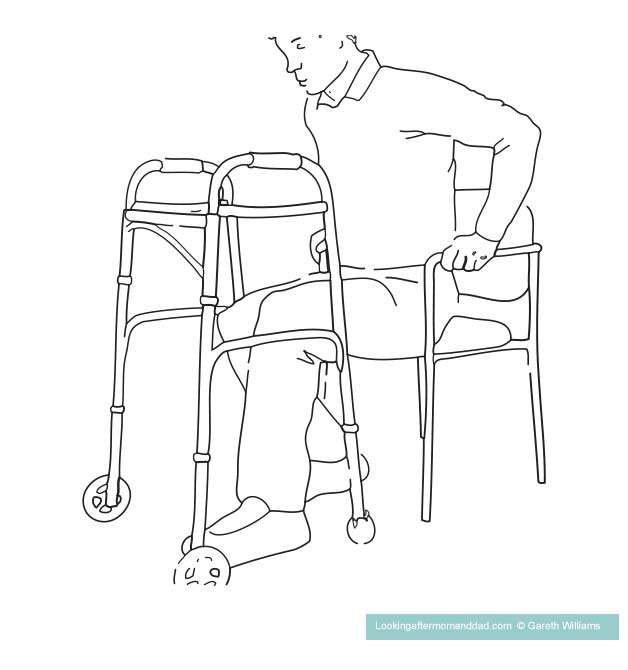
5
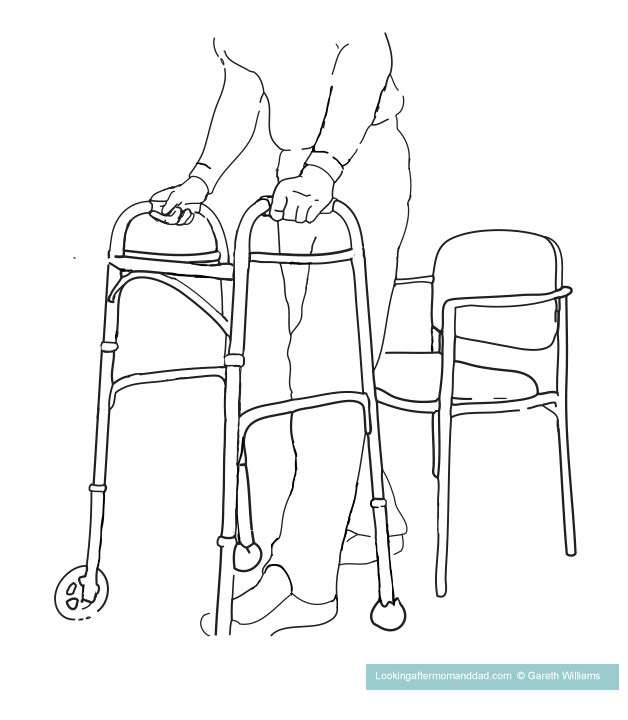
3
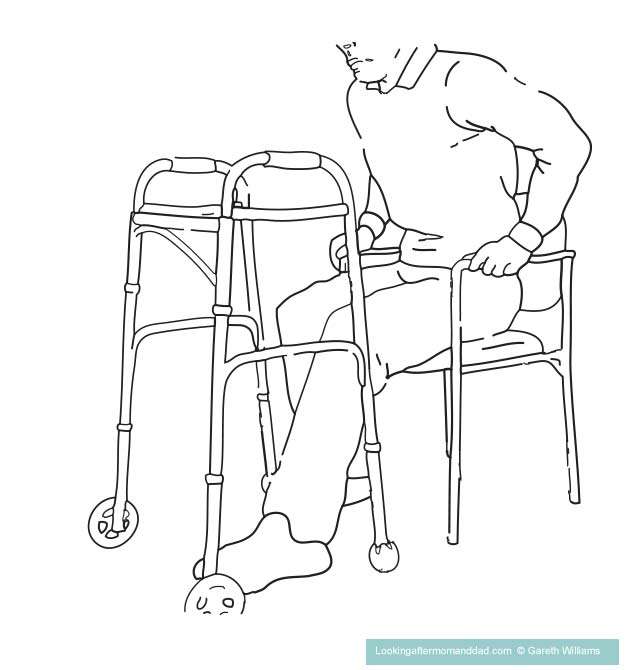
6
How sit down in a chair after a hip replacement ?
To sit down in a chair after a hip replacement, you will be using a walker to help you with your stability and balance.
A quick guide to sitting down in a chair after a hip replacement –

1
- using a walker, back up to the chair

2
- stop when you feel the back of your legs touching against the seat of the chair

3
- extend your leg out in front of you without putting weight on it

4
- reach back with your hand on your hip replacement side for the armrest of the chair same side
- once you have hold of the armrest, you can reach back with the other hand taking hold of the other armrest
- now putting your weight into your arms, and your good leg, you can sit back on the front edge of the seat
- as you sit down do not bend or lean forwards, but take your weight down through your arms keeping your back nice and straight

5
- sit back on the front edge of the chair seat

6
- using your arms, lift your weight off your bottom, and scoot back further into the seat
- as well as your arms, you can use your good leg to help you scoot back, but don’t twist your hips
- don’t lean forwards to do this
When can I sit in a normal chair after a hip replacement ?
Once again, if you have had an anterior this does not apply to you, except to say don’t sit in really low chairs as they can cause you to strain yourself a little just after surgery ! And if you want to be on the safe side, check with your surgeon.
For those of you with a posterior, or lateral hip replacement, you should not sit in a “normal” chair, for up to 6 to 10 weeks.
You should also be waiting until your surgeon tells you it’s okay, which may be at your post operation assessment, which should be 6 weeks after surgery, or a little later depending on your recovery progress.
Even if you have the okay to sit in a normal chair, you may want to continue to use one with armrests until 3 months after your surgery.
This will help you to use your arms to push, and to maintain good posture when standing, and so place less stress on the joint, and letting it continue to heal.
But until you are told it is okay, you need to sit in a chair with –
- a straight back
- armrests
- a solid seat
- a seat level which has your hip higher, or level, but not below, your knees
During the initial period post surgery, you should avoid –
- rocking chairs
- low stools
- chairs on wheels
- most recliners (but find out from your surgeon)
- sofas
- all chairs with a seat lower than the height of your knee from the floor
- all chairs without armrests
Can I sit with my legs up after a hip replacement ?
If you want to put your feet up when sitting, just make sure that you don’t break the 90 degree rule, i.e. make sure your hip isn’t at a 90-degree angle or higher – don’t have your hip at more than a right angle.
Don’t sleep with your feet up, and don’t sleep with pillows under your knees, as you are putting stress on the hip in these positions.
Using a recliner after a hip replacement: Can you do it ?
You have to ask your surgeon if they recommend this, in your particular case or not, or not.
I have looked high and low for answers on this, and I have never seen so many contradictory answers, most of which are in relation to posterior and lateral hip replacements.
Some clinics flat out say don’t sit in sofas, low seats, and recliners. While other clinics say that recliners are fine.
The issues around recliners relate to –
- the height of the seat
- the type of reclining mechanism
- does your recliner have the right kind of lever that you don’t strain yourself getting back to the upright seated position
- breaking the 90 degree rule when you stand up
- can you scoot forwards (they have deep seats) to the edge of the seat without hurting the hip, to stand up
- do you have strong enough arms to stand up from the seat without hurting your hip by leaning forwards (which you should not do)
- whether the seat has an electric lift mechanism
- if you have an electric lift mechanism, is the seat actually high enough from the floor not to have your bottom lower than your knees when you are seated upright
Opinion seems to be that they are great to sit in, in a reclined position (never breaking the 90 degree rule), but getting in and out appears to be the issue.
For anterior hip replacements, there are two precautions –
- do not sleep in them as it will lead to your hip stiffening up
- do not use them if they have a very low seat, and you are tall
My mom, who was 88 when she had her hip replacement, sat the whole time in an upright chair, and, when she was finding things uncomfortable, lay in bed.
Once again, I would say that you really need to ask your surgeon if they advise a recliner in your case, and if so which type, and get them to give you the seat height that you need if they say yes.
Sources for this article –
https://www.edwinsu.com/anterior-hip-replacement-post-op-instructions.html
https://www.newyorkhipknee.com/faqs/total-hip-replacement-faqs/
https://www.stefankreuzermd.com/anterior-hip-replacement.html
https://www.orthonewengland.com/wp-content/uploads/sites/156/2018/02/KENNON-DISCHARGE-INSTRUCTIONS-HIP-2016.pdf
I’m Gareth, the author and owner of Looking After Mom and Dad.com
I have been a caregiver for over 10 yrs and share all my tips here.

